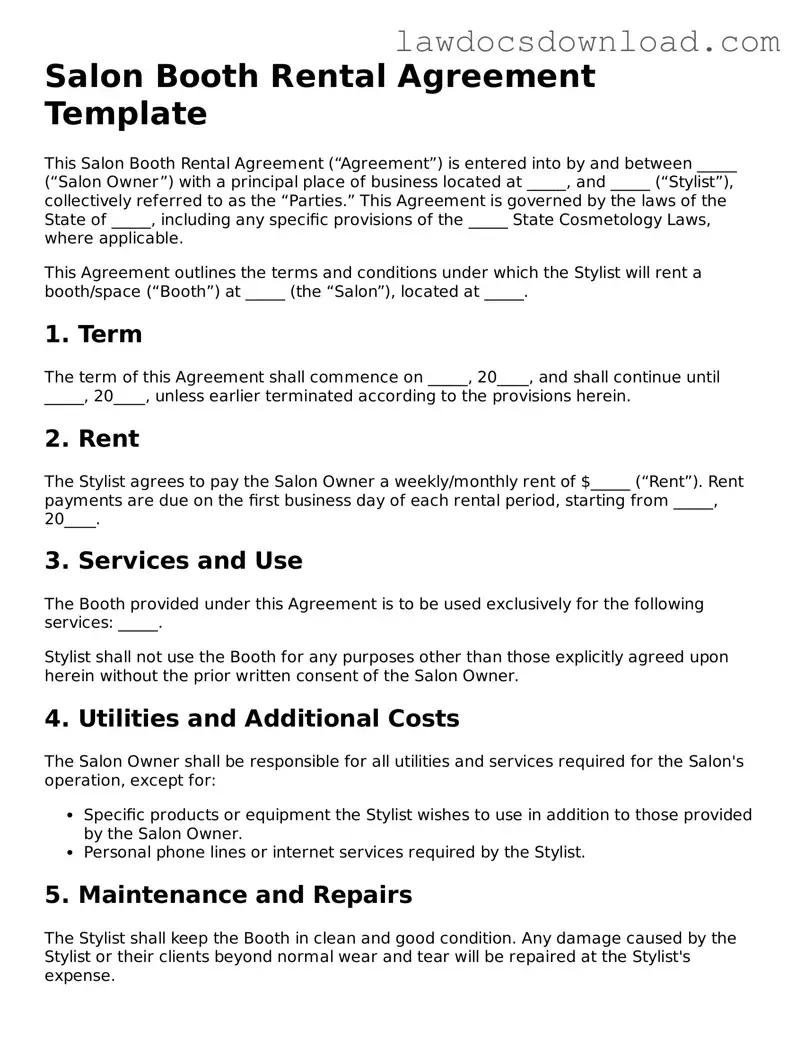Salon Booth Rental Agreement Template
This Salon Booth Rental Agreement (“Agreement”) is entered into by and between _____ (“Salon Owner”) with a principal place of business located at _____, and _____ (“Stylist”), collectively referred to as the “Parties.” This Agreement is governed by the laws of the State of _____, including any specific provisions of the _____ State Cosmetology Laws, where applicable.
This Agreement outlines the terms and conditions under which the Stylist will rent a booth/space (“Booth”) at _____ (the “Salon”), located at _____.
1. Term
The term of this Agreement shall commence on _____, 20____, and shall continue until _____, 20____, unless earlier terminated according to the provisions herein.
2. Rent
The Stylist agrees to pay the Salon Owner a weekly/monthly rent of $_____ (“Rent”). Rent payments are due on the first business day of each rental period, starting from _____, 20____.
3. Services and Use
The Booth provided under this Agreement is to be used exclusively for the following services: _____.
Stylist shall not use the Booth for any purposes other than those explicitly agreed upon herein without the prior written consent of the Salon Owner.
4. Utilities and Additional Costs
The Salon Owner shall be responsible for all utilities and services required for the Salon's operation, except for:
- Specific products or equipment the Stylist wishes to use in addition to those provided by the Salon Owner.
- Personal phone lines or internet services required by the Stylist.
5. Maintenance and Repairs
The Stylist shall keep the Booth in clean and good condition. Any damage caused by the Stylist or their clients beyond normal wear and tear will be repaired at the Stylist's expense.
6. Insurance
Both Parties agree to maintain adequate insurance to cover their respective activities related to this Agreement. Proof of insurance must be provided to the other party upon request.
7. Termination
This Agreement may be terminated by either Party upon _____ days' written notice. In the event of termination, the Stylist is responsible for paying rent up until the termination date.
8. Governing Law and Dispute Resolution
This Agreement shall be governed by and construed in accordance with the laws of the State of _____. Any disputes arising out of this Agreement shall be settled through mediation, or if necessary, legal action in the state's courts.
9. Entire Agreement
This document represents the entire agreement between the Parties regarding the Booth rental at the Salon and supersedes all previous discussions, agreements, or understandings, whether oral or written.
10. Amendment
This Agreement may only be amended in writing, signed by both Parties.
IN WITNESS WHEREOF, the Parties have executed this Agreement as of the latest date set forth below.
Salon Owner's Signature: __________________________________ Date: _____, 20____
Stylist's Signature: __________________________________ Date: _____, 20____
